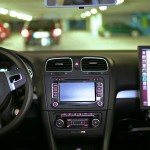Project Overview
 Electric vehicles hold the promise of sustainable mobility for the years ahead. But current technology has significant limitations such as reduced driving ranges and long charging times. As such, today’s electric cars are not yet a realistic alternative to conventionally powered vehicles when considering long-distance journeys. This is why scientists are developing novel approaches that combine not only short- and long-haul travel but also public and private modes of transportation. One such concept is currently being developed by a team of researchers at ETH Zurich and the universities of Braunschweig, Oxford, and Parma, in collaboration with industrial partners Bosch and Volkswagen AG. Their EU-funded project is called V-Charge, which stands for “valet parking and charging,” and it envisions a world in which travelers complete most interurban journeys using a well-developed long-distance transportation network and then switch to comfortable electric vehicles for the last few miles home from the railway station. To support this vision, the researchers are developing V-Charge park & ride car parks, where fully automated electric vehicles will be able to make their way to charging stations or parking spaces. Travelers simply use a smartphone app to send their vehicle to charge itself. Once it is fully charged, they can summon it just as easily via the app to come and pick them up.
Electric vehicles hold the promise of sustainable mobility for the years ahead. But current technology has significant limitations such as reduced driving ranges and long charging times. As such, today’s electric cars are not yet a realistic alternative to conventionally powered vehicles when considering long-distance journeys. This is why scientists are developing novel approaches that combine not only short- and long-haul travel but also public and private modes of transportation. One such concept is currently being developed by a team of researchers at ETH Zurich and the universities of Braunschweig, Oxford, and Parma, in collaboration with industrial partners Bosch and Volkswagen AG. Their EU-funded project is called V-Charge, which stands for “valet parking and charging,” and it envisions a world in which travelers complete most interurban journeys using a well-developed long-distance transportation network and then switch to comfortable electric vehicles for the last few miles home from the railway station. To support this vision, the researchers are developing V-Charge park & ride car parks, where fully automated electric vehicles will be able to make their way to charging stations or parking spaces. Travelers simply use a smartphone app to send their vehicle to charge itself. Once it is fully charged, they can summon it just as easily via the app to come and pick them up.
https://www.youtube.com/watch?v=zrronWEhI4Y
The project was launched in June 2011 and reached an important milestone on April 2, 2014, when the scientists presented the latest version of their fully automated driving and parking function in the Bosch parking garage at Stuttgart airport. They successfully demonstrated fully automated valet parking triggered from a smartphone app. After receiving the trigger, the vehicle connects to the parking garage’s server, determines the location of a vacant parking space, and then drives itself to that space. If another vehicle crosses its path, the vehicle either stops to let it pass or maneuvers to avoid it.
Contributions
Being part of the Technische Universität Braunschweig team, I am responsible for server infrastructure, system security, and resource management within the V-Charge project. In particular, our contribution includes:
- Communication framework: Sophisticated vehicle-to-infrastructure (V2I) and vehicle-to-vehicle (V2V) communications, enabling distribution of mission information to connected vehicles, system monitoring and remote debugging, including security and trust concepts. Communication with mobile user devices (smartphones) for customer interaction.
- Efficient management and assignment of charging stations and parking spots to connected EVs. Evaluation of scheduling algorithms based on real-world parking statistics to learn their suitability for different usage scenarios.
- Central back-end server: Parking/charging management, storing, updating, and distributing map data.
V-Charge is a collaborative research project being coordinated by ETH Zurich with contributions from the universities of Braunschweig, Oxford, and Parma together with Bosch and Volkswagen AG. The project is receiving funding from the EU’s Seventh Framework Programme for Research (V-Charge, project number 269916) and has an overall budget of 5.63 million euros. It is set to run from June 1, 2011 to September 30, 2015.
For more information, visit the V-Charge website at the Institute of Operating Systems and Computer Networks.




